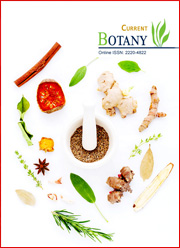Morphological and cultural variations of Alternaria brassicae isolates from mustard crop of Allahabad, Uttar Pradesh
DOI:
https://doi.org/10.25081/cb.2024.v15.8914Keywords:
Alternaria brassicae, Leaf spot diseases, Morphological variations, Cultural growth, Mustard cropAbstract
Mustard is the most economically important genus of the family Cruciferae. It is an oil seed crop grown under a wide range of agro-climatic conditions in India. Among the various fungal diseases occurring on mustard, Alternaria leaf spot caused by Alternaria brassicae is one of the devastating diseases reported to cause 10-70% yield losses. Variations in morphological and cultural characteristics among 31 representatives in Allahabad geographical isolates of A. brassicae. Different isolates showed high-level variability in vitro concerning growth pattern, sporulation, conidial length, width, and number of septa. Conidia of Allahabad isolate (II-1b21) was the smallest in size with the lowest number of horizontal and vertical septa. Conidia of Allahabad isolate (IV-8A21) and (II-7C21) showed the largest in size with the highest number of horizontal and vertical septa. Substantial variation was found in mycelial growth and sporulation among these isolates in different culture media, temperature, pH and relative humidity. However, Potato Dextrose Agar, oatmeal agar, Czapex dox agar, Carrot meal agar and V-8 juice Agar were best for all the cultures. The highest radial growth was shown in the OMA medium by III-6C20 isolates, while the lowest growth was shown in the CA medium by II-7C21 and II-8B21 isolates. Out of all of them, the isolate from Barwa (I-6B121) sporulated the most (41.75x105/mL) whereas the isolate from Shekhsarwa (I-4A21) sporulated the least (0.5x105/mL). The various isolates showed varying rates of mycelial development and sporulation at various pH values. Phoolpur isolate (UN120), Sahso (II-4II20), Bhandra Naini isolate (III-5C21), SHUATS Naini isolate (III-6C20), Among the 31 isolates,9 isolates II-UN120 from Phoolpur, PRG, IV-5C20 from Malak har har Soraon, I-4A21 from Shekhsarwa, I-6B21 from Barwa PRG, I-6A1y21 from Barwa PRG, II-8B21 from Devnahri Phoolpur, III-6C21 from Sarangpur, IV-4B21 from Phaphamau, and IV- 6AY21 from Morahu were found to be high degree of infection as the spot produced by them were more than 10 mm in diameter. A dendrogram was created using the Unweighted Pair Group Method with Average Means (UPGMA) to analyze the morphological and cultural characteristics of A. brassicae isolates on nutrient media. This dendrogram identified two major clusters with 90% similarity. One cluster (group I) comprised 24 isolates while another cluster (group II) comprised of remaining seven isolates. Isolates of Karchana, Meja, and Koraon were found to be more similar to each other whereas Handia, Phoolpur, and Soraon isolates were distantly related to each other.
Downloads
References
Ansari, N. A., Khan, M. W., & Muheet, A. (1989). Effect of some factors on growth and sporulation of Alternaria brassicae causing Alternaria blight of rapeseed and mustard. Acta Botanica Indica, 17, 49-53.
Berkeley, M. J. (1836). Fungi. In J. E. Smith & J. W. Hooker (Eds.), The English Flora (Vol. 5, pp. 339-340) Longman, Londan, UK: Longman. pp. 339-340.
Butler, E. J. (1918). Fungi and diseases in plants. Ballimaran, Delhi: Jayyed Press.
Chattopadhyay, C. (2008). Management of diseases of rapeseed mustard with special reference to Indian conditions. In A. Kumar, J. S. Chauhan & C. Chattopadhyay (Eds.), Sustainable Production of Oilseeds: Rapeseed-Mustard Technology (pp. 364-388) Udaipur, India: Agrotech Publishing Academy.
David, J. C. (1991). IMI Descriptions of Fungi and Bacteria No. 1075 Alternaria linicola. Mycopathologia, 116, 53-55.
Goyal, P., Chahar, M., Mathur, A. P., Kumar, A., & Chattopadhyay, C. (2011). Morphological and cultural variation in different oilseed Brassica isolates of Alternaria brassicae from different geographical regions of India. The Indian Journal of Agricultural Sciences, 81(11), 1052-1058.
Johnson, R. A., & Wichern, D. W. (1996). Applied multivariate statistical analysis. New Delhi, India: Prentice-Hall of India Private Limited.
Kaur, S., Singh, G., & Banga, S. S. (2007). Documenting variation in Alternaria brassicae isolates based on conidial morphology, fungicidal sensitivity and molecular profile. Plant Protection: Diseases, 4, 87-89.
Kumar, R., & Gupta, P. P. (1994). Survival of Alternaria brassicae, A. brassicicola and A. alternata in the seed of mustard (B. juncea) at different temperatures and relative humidities. Annals of Biology, 10, 55-58.
Lapis, D. B., & Ricaforte, E. T. (1974). Alternaria leaf spot of crucifers in the Philippines. Philippines Agriculturist, 58(3-4), 121-137.
Meena, P. D., Awasthi, R. P., Chattopadhyay, C., Kolte, S. J., & Kumar, A. (2010). Alternaria blight: a chronic disease in rapeseed-mustard. Journal of Oilseed Brassica, 1(1), 1-11.
Meena, P. D., Chattopadhyay, C., Kumar, V. R., Meena, R. L., & Rana, U. S. (2005). Spore behaviour in atmosphere and trends in variability of Alternaria brassicae population in India. Journal of Mycology and Plant Pathology, 35, 511.
Saccardo, P. A. (1886). Sylloge fungorum omninum hucusque cognitorum. Pavia, Italy: Patavii.
Simmons, E. G. (2007). Alternaria: An Identification Manual. Utrecht, The Netherlands: CBS Biodiversity Series No. 6.
Singh, D., Singh, R., Singh, H., Yadav, R. C., Yadav, N., Barbetti, M., Salisbury, P., Nimbal, S., Chattopadhyay, C., & Kumar, A. (2007). Cultural and morphological variability in Alternaria brassicae isolates of Indian mustard (Brassica juncea L. Czern & Coss.). Plant Protection: Diseases, 158-160.
Verma, P. R., & Saharan, G. S. (1994). Monograph on Alternaria Diseases of Crucifers. Saskatoon Research Centre, Canada: Research Branch Technical Bulletin 1994-6E.
Waugh, M. M., Kim, D. H., Ferrin, D. M., & Stanghellini, M. E. (2003). Reproductive potential of Monosporascus cannonballus. Plant Disease, 8(1), 45-50. https://doi.org/10.1094/PDIS.2003.87.1.45
Published
How to Cite
Issue
Section
Copyright (c) 2024 Shailendra Kumar, S. M. Prasad, H. K. Kehri

This work is licensed under a Creative Commons Attribution-NonCommercial 3.0 Unported License.



 .
.